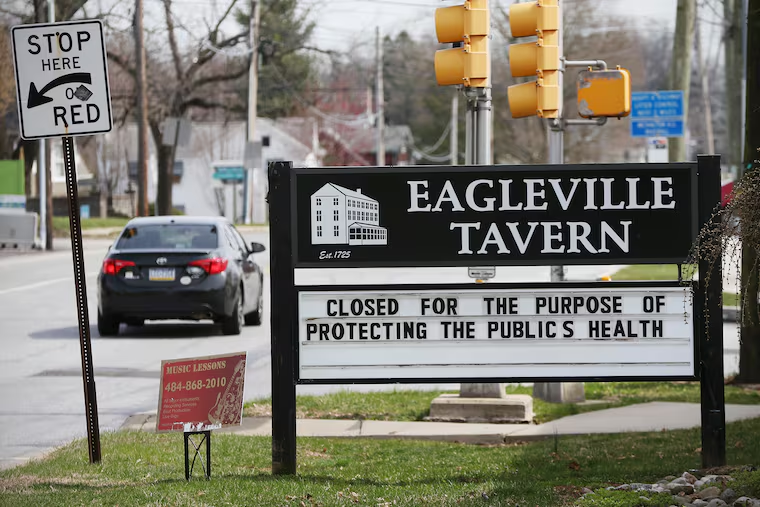Coronavirus shutdown was needed, but unseen health risks of restrictions need consideration | Expert Opinion
The limits of telemedicine and an increase in sedentary lifestyles are two downsides to the shutdown.

As an emergency physician in one of the hardest-hit counties in Pennsylvania, I have witnessed firsthand the devastation of the coronavirus pandemic on patients, families, and heroic health-care workers. Our public officials were right to institute social distancing and lockdown restrictions, measures that have saved lives and kept hospitals from being overwhelmed, as has happened in other large cities.
After two months of lockdown, the debate over lifting restrictions is raging. Missing from this debate has been the consideration of a crucial reality. While the health risks of easing restrictions are clear, the health risks of continuing restrictions have not been discussed or quantified. I am not a public health expert, nor am I advocating for a particular approach. We must, however, recognize the health risks involved with either approach. The thoughts that follow are suggestive, not comprehensive, and should be developed by those with more expertise than I.
Much has already been published on the mental health impact of social restrictions. In my practice, the number of patients with a new diagnosis of anxiety has skyrocketed. Patients with preexisting mental illness are faring even worse, unable to speak face-to-face with a counselor or therapist. Social isolation increases the risk of substance abuse, overdoses, and suicide. High unemployment has worsened the food insecurity in an already vulnerable population and created new insecurity in those unaccustomed to it. Losing the sense of purpose many people find through work may be hard to measure, but doubtless contributes to feelings of depression and worthlessness.
Far less attention has been given to the inadvertent physical health risks of these restrictions. Our lives have become more sedentary, and that is known to be unhealthy. There is a complex and mysterious interplay between body and soul, and we have long known that emotional well-being contributes to physical recovery. However, as most hospitals have (rightly) restricted visitors, patients have to recover on their own. In the saddest of situations, patients are dying alone in the hospital, with family present by video chat only.
For others who are not sick enough to be in the hospital, access to routine care is severely limited. While telemedicine has exploded in this vacuum, a doctor still can’t press on your abdomen (or put her hand on your shoulder), and diagnoses are being missed. Patients who need an office-based evaluation of serious conditions are faced with delays, risking deterioration, complications, and death. We will never know how many patients with stroke or heart attack symptoms avoided seeking medical care for fear of contracting the coronavirus in the hospital; and a tragic few have waited too long. As unemployment rises, fewer patients will be able to afford co-pays and medications, and many will lose their insurance coverage altogether. Even after restrictions are lifted, there will be a tremendous backlog in “routine” care, which will lead to long delays for all.
The health-care infrastructure was struggling before this pandemic with decreasing reimbursements, increasing costs, increasing regulation, and a hostile malpractice climate. Our regional health-care institutions should be commended for their response, which has been to stop elective and outpatient work (decreasing revenue) while protecting and providing for their workers (increasing costs). It may seem counterintuitive, but a medical crisis is actually resulting in less health-care delivery. This is creating a tremendous strain on an already fragile industry. Hospitals in underserved areas will not be able to survive a prolonged lockdown.
As large health-care institutions and hospitals struggle, smaller independent physician groups lack the financial reserves to weather the storm. Nonprofit agencies, such as private ambulance companies, are at even greater risk of failure, as they have maintained 24/7 readiness with increased costs, decreased revenue, and without municipal support. If restrictions are maintained for too long, a citizen who becomes ill may not have an ambulance nearby to respond, or a hospital nearby to care for him, or a doctor nearby to manage his long-term recovery, or a nonprofit community organization to fill in the gaps. This lack of access will persist long after the restrictions end, and may never fully return to pre-pandemic levels.
While easing restrictions presents health risks, so does maintaining them. Our leaders and health officials must recognize and balance all of these risks so that we can wisely decide what is best for the long-term health of our communities.
A final plea: If you’re sick, please come to the hospital. Full protective measures are in place, and we are ready to care for you safely. Please don’t stay home out of fear.
Joseph S. Bushra is an emergency medicine specialist at Lankenau Medical Center in Wynnewood. This column reflects his personal views, not those of his employer.